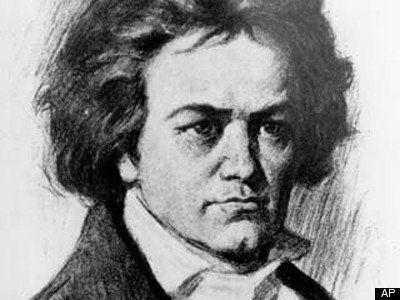
It is December, the time for classical music's holiday fare.
It may be one of the only Christmas-related events that does not start at Halloween.
I am not sure how and when the opera Hansel and Gretel became a holiday treat. It does not strike me as appropriate. Is it the gingerbread men? Endless candy? Certainly it cannot be about the abusive parents. Victor Herbert's operetta Babes in Toyland seems more fitting. Menotti wrote Amahl and the Night Visitors, the first opera composed for a television audience around the biblical Christmas story and it is definitely an audience-pleaser for the story and the brevity.
Presently I am singing the alto solo in the Beethoven's Ninth with San Diego Symphony. It does not really come to mind as a holiday work.
Many people know the Ninth for the familiar "Ode to Joy," which comprises the final movement. The whole symphony In short, rocks for a solid hour. That such a large group can work together, play in tune for an hour straight and end up at the same place is pretty amazing. It is not unlike a baseball game with bases loaded, bottom of the ninth (no pun intended) but no dugout of back up players. I admit there are times I have not appreciated the work but watching these musicians brought me back to the fold. It is a tremendously moving piece. One cannot help but feel good after hearing it. I sort of wish the audience could move around and dance during some of it. I have a hard time sitting still, myself.
We mezzos joke a lot about singing this piece because the part sits low and we can rarely be heard. We say -- wear a flashy dress so at least you will be seen if not heard. Admittedly, I feel a little guilty taking a paycheck for such a part. (The concerts were originally programmed to be Hansel and Gretel but was changed.) To appease this frustrating "alto-itis," the great conductor Bernard Haitink once told me, while recording the equally thankless Bruckner Te Deum, that even though it seems useless, the listener would miss the middle pitches that complete the chords. This made me feel much better.
Normally, for concerts such as these, the soloists sit in front of the orchestra, which has its good and bad aspects: Bad -- you feel like the audience can see any move you make so you try to not move for risk of being distracting, and it is harder to see the conductor as he would be in our peripheral view. Good- the audience can see you better and most likely hear better.
During these concerts in San Diego we sit just in front of the choir but behind the orchestra. Sitting out of view allows me to tap my feet and hear the orchestra from a totally different perspective -- right behind the timpani and brass section. I look over the wide swath of players to see everyone concentrating at warp speed in order to make the piece come together. Behind me I hear the individual voices of the choir that one would not hear from afar.
These players and singers work really hard with stellar results. It is an amazing energy to witness and feel through the floorboards. I have often wished a scientist would wire everyone to see if they could generate enough electricity to light a small town. The conductor has the unenviable task of keeping over 60 people together on the same beat. Our conductor, John Nelson, shows every inch of emotion while conducting. Players also have to listen and watch each other. Whereas I sing from a score that shows all the parts, they play from music that shows only their own part. Each one is part of a whole and without just one instrument it would not sound the same (kind of like my alto line.) Hmm... Not a bad metaphor...
I think anyone would become a classical music lover if they could see an orchestra from where I sit. The timpanist has a line up of mallets to use, some wood tipped, other felt tipped. He keeps them in a satchel like a carpenter would keep his tools of the trade. He continually leans over his instruments to check if they are maintaining their pitch. The material stretched over the top can tighten and loosen depending on the humidity and temperature. He stays cool as a cucumber as the piece gets faster. He looks as though this is what he lives for.
To the right I see seven string bass players. Their left hands crawl like manic spiders up and down the long necks of the instruments while the other hand controls the bow running across the strings. It is a kick to watch this incredibly physical activity. The other strings have a similar job but on a smaller scale. The higher the instrument: the shorter the neck. All of these string players seem like their instrument is another appendage, their bows moving in unison. I feel I am watching a flock of birds taking off. One cellist is so intense, his face full of determination, eyes like a laser through his music. One look away for anyone and they might make an audible mistake.
The brass section is right in front of the timpani. Many of the musicians in front of the brass use ear plugs so as to not have damage to their hearing. I would hate to be a brass player. The slightest flaw is so obvious. These players calmly play incredibly tricky music. At times they wait a long while to play and they have to count the entire time to know when to play again. Periodically they dislodge an appendage of their horn to blow out any condensation that has built up. As gross as that sounds, it is necessary to make a clear tone.
The winds always seem to be racing with each other. There are far fewer of these than there are string instruments. They must play like a small ensemble in a larger one. The clarinets also clear the condensation but with a long scarf looking fabric that they pull through the body. I think if I came back as an instrument I would be a bassoon. It is a sound like no other, in a long awkward looking body. I would describe the tone as bubbly. (no letters, please)
Lastly there is the work itself -- Beethoven's last symphony, a majestic masterpiece that has lasted for 187 years. He was deaf when he composed it, a feat in itself, and is the first composer to add the human voice to a symphonic piece. The text is by the German poet Friedrich Schiller with some tweaking by Beethoven. The composer was to have said, "a great poem is more difficult to set to music than a merely good one because the composer must rise higher than the poet." No doubt he achieved this.
Schiller's message is that even the simplest thing or being is touched with divinity and can be seen as part of a greater universe. We are all connected. We are a brotherhood. What better message could be conveyed by an orchestra, choir and four soloists -- a group of individuals and instruments of all shapes and sizes coming together to work as a whole. The audience becomes a part. There is nothing like the cut off of the large chord at the end, reverberating like a tsunami encompassing the audience.
Frankly, I have a hard time thinking of a better theme for this time of year and for our world at large. I suggest that we all crank up the stereo and sing at the top of our lungs. Go to the next live event in your area. Support the arts. They do not exist in a void but are a reflection of our souls. They are timeless and important for our well-being just as they have been for hundreds of years.
Better yet, give tickets to an arts event as a gift instead of the usual sweater or high-tech gadget. More bang for your buck.
